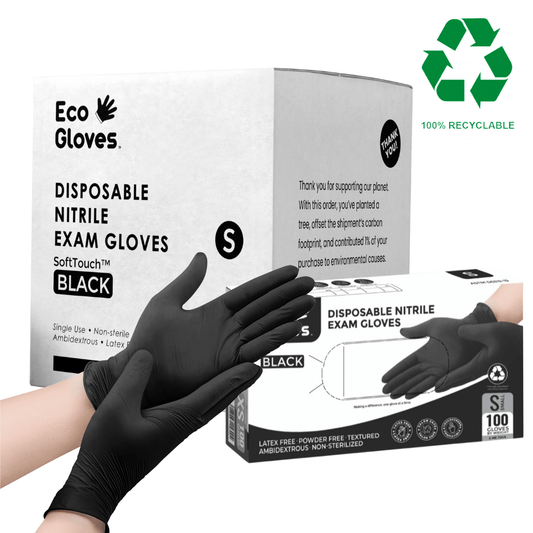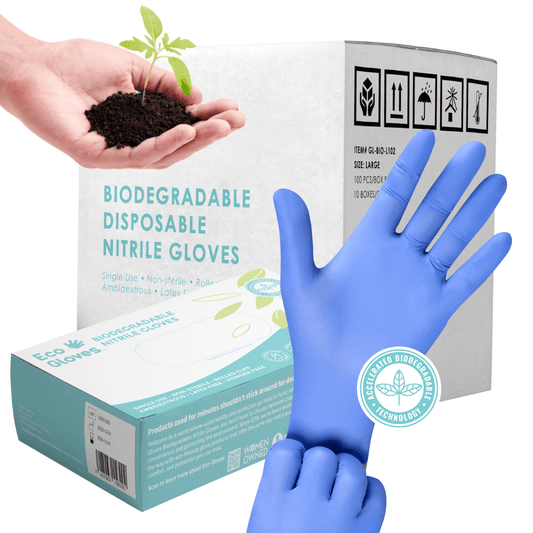Nitrile vs. Latex vs. Vinyl vs. Polyethylene Gloves: Which Should You Choose?
Eco Gloves
Why Choosing the Right Glove Matters
Not all disposable gloves are created equal. Whether you’re preparing food, treating patients, or cleaning facilities, the right glove can protect your hands—and your reputation.
Each material—nitrile, latex, vinyl, and polyethylene (PE)—offers unique benefits in terms of safety, comfort, cost, and environmental impact. This guide breaks down how they compare so you can choose the best option for your business or household use.
Topics Covered
- Quick Comparison Chart: Disposable Glove Materials at a Glance
- Safety & Allergen Considerations for Disposable Gloves
- Durability and Performance in Various Types of Disposable Gloves
- Best Glove Materials by Industry
- Nitrile vs Latex Gloves: When Does Each Win?
- Vinyl vs Nitrile Gloves: The Hygiene & Safety Gap
- Environmental Impact and Sustainable Glove Alternatives
- How to Choose Gloves: A Simple Decision Flow
- Purchasing Tips for Consumers and Businesses
- Key Takeaways
- Conclusion: Make the Right Choice, Then Make It Sustainable
- Frequently Asked Questions (FAQs)
Quick Comparison Chart: Disposable Glove Materials at a Glance

Safety & Allergen Considerations for Disposable Gloves
When safety is your priority, start with the standards and science.
Regulatory Basics
In the U.S., medical gloves (exam, surgical, chemo) are regulated as Class I devices and require FDA 510(k) clearance to confirm leak resistance, physical properties, and biocompatibility. Food handling gloves are regulated separately by the FDA’s Center for Food Safety and Applied Nutrition (CFSAN); they are not medical devices and rely on food-contact compliance and proper labeling.
Latex Allergy
Natural rubber latex can cause immediate (IgE-mediated) reactions, including anaphylaxis, or delayed contact dermatitis due to processing chemicals. Prevalence is notably higher in healthcare workers because of repeated exposure. If you’re unsure about sensitivities, opt for latex-free disposable gloves, such as nitrile gloves or plant-based, compostable gloves, for short tasks.
Vinyl and Plasticizer Concerns
Some vinyl gloves (PVC) have historically been made with phthalate plasticizers like DEHP. Peer-reviewed and NGO testing reports have shown migration of these plasticizers into foods causing potential health risks. If you use vinyl, it is always good to confirm the gloves are phthalate-free and food-safe before using them in kitchens, otherwise, consider switching to nitrile or compostable options for food prep tasks.
Fit & Barrier integrity
Barrier failure skyrockets when gloves are too loose or too tight. Nitrile typically offers better puncture resistance than latex with certain probes, although the tool used (e.g., needle vs. steel probe) can influence results. This is why selection should consider the task (needles vs. general handling) and thickness (mil).
Employer's Duty of Care
Under OSHA 1910.138, employers must select appropriate hand protection based on the hazards, chemicals, cuts, punctures, temperature, and train employees to use and change gloves correctly.

Durability and Performance in Various Types of Disposable Gloves
When it comes to disposable gloves, not all materials perform the same. Some are built for strength and endurance, while others are meant for speed and convenience. Here’s a quick look at how nitrile, latex, vinyl, and PE gloves stack up in durability and everyday use.
Nitrile Gloves
- ✅ Best overall protection: Excellent for puncture resistance, chemical handling, and long wear.
- ✅ Latex-free: Safe for users with allergies.
- 💡 Tip: Choose 3–4 mil thickness for general use, and 5–6 mil for heavy-duty or chemical tasks.
Latex Gloves
- ✅ Superior flexibility and comfort: Feels like a “second skin,” ideal for precision work.
- ⚠️ Allergy caution: Not suitable for shared or public-use environments.
Vinyl Gloves
- ✅ Budget-friendly: Easy to don and ideal for short, low-risk tasks.
- ⚠️ Limited durability: Prone to micro-tears during use. Avoid for long tasks or high-hygiene environments.
Polyethylene (PE) Gloves
- ✅ Ultra-economical: The go-to option for food sampling and grocery handling.
- ⚠️ Minimal protection: Designed for single use; change frequently between tasks.
For a deeper dive into plastic glove hygiene trade-offs in food service, see what every food business and food handler should know about plastic gloves and the primer on PE gloves.
Best Glove Materials by Industry

Nitrile vs Latex Gloves: When Does Each Win?
If you’re debating nitrile vs latex gloves, prioritize allergy risk management and task demands:
- Go nitrile when you must be latex-free, need strong puncture/chemical resistance, or want consistent performance across staff with unknown sensitivities.
- Go latex when ultra-high dexterity and stretch matter most, and your workplace has strict controls for latex exposure and alternatives on hand for sensitive users.
Vinyl vs Nitrile: The Hygiene & Safety Gap
For vinyl vs nitrile, budget vs performance is the trade-off. Nitrile offers superior barrier integrity and durability. Vinyl is inexpensive and easy for rapid changeovers, but it can develop micro-tears and, depending on formulation, may contain plasticizers of concern. For higher-risk environments (healthcare, high-volume kitchens, messy prep), choose nitrile gloves.
Environmental Impact and Sustainable Glove Alternatives
No disposable glove is completely impact-free, but your choice of material and manufacturing source can make a significant difference. Understanding how each glove type affects the environment helps you make smarter purchasing decisions that align with both safety and sustainability goals.
Manufacturing and energy use:
Life-cycle studies (LCAs) show that most of a glove’s carbon footprint comes from energy-intensive manufacturing and raw material production. For example, nitrile and latex gloves tend to have higher energy demands during production. Choosing gloves from manufacturers that use renewable energy or efficient processes can meaningfully reduce emissions.
Carbon intensity and waste reduction:
Among common glove types, nitrile gloves rank higher in carbon impact per kilogram of material. The best way to lower that footprint is to buy quality gloves that last longer in use and minimize waste from frequent tearing or overuse. Some modern biodegradable nitrile gloves also help reduce end-of-life impact.
Latex (natural rubber):
Latex gloves are made from renewable natural rubber, but their sustainability depends on plantation practices. Poorly managed rubber expansion has been associated with deforestation in tropical regions, making responsible sourcing key to reducing ecological harm.
Vinyl (PVC):
Vinyl gloves are inexpensive but come with environmental and health trade-offs. Studies have flagged potential migration of plasticizers (phthalates) into foods, and PVC’s production can release harmful byproducts. Many facilities now transition to nitrile or compostable options for cleaner, safer alternatives.
Polyethylene (PE):
Conventional PE gloves are lightweight and affordable but non-biodegradable, often persisting for decades in landfills. Where industrial composting is available, plant-based compostable PE gloves provide a more responsible end-of-life option.
🌱 For a deeper look at how compostable and biodegradable materials reduce plastic waste, see What Makes Compostable Gloves Better for the Environment.
Eco Gloves offers biodegradable nitrile and compostable plant-based gloves designed to minimize waste and carbon impact without sacrificing safety or quality. Learn more about our sustainability initiatives →
How to Choose Gloves: A Simple Decision Flowchart

Purchasing Tips for Consumers and Businesses
1. Match the mil to the task. Thicker gloves cost more per box but can reduce change frequency and tear waste, resulting in net savings in busy environments.
2. Avoid false economy. Lower-cost vinyl can increase contamination risk if micro-perforations form; better to step up to nitrile for hygiene-critical tasks.
3. Buy in bulk for consistency. Larger orders reduce lot-to-lot variation and help ensure steady sizing and tactile performance, vital for healthcare, cleaning, and food operations.
Shop bulk options →
4. Audit your waste stream. If you have industrial compost access, run a pilot with compostable gloves at low-risk stations and measure diversion.
Key Takeaways
- Nitrile gloves offer the best all-around safety, comfort, and durability.
- Latex gloves provide unmatched flexibility but pose allergy risks.
- Vinyl and PE gloves are budget-friendly options for quick, low-risk tasks.
- Eco alternatives like biodegradable nitrile and compostable gloves support sustainability goals.
- Always match glove material and thickness to the task for safety and cost efficiency.

Conclusion: The Right Glove Protects More Than Hands
Choosing the right disposable glove is about more than comfort—it’s about protecting people, products, and the planet.
At Eco Gloves, we make it easy to find your perfect fit. From premium nitrile and vinyl gloves to eco-friendly biodegradable and compostable options, you’ll find reliable protection for every task, budget, and industry.
Explore Eco Gloves’ full collection →
Learn about our Sustainability Efforts →
Frequently Asked Questions (FAQs)
-
Are nitrile gloves better than latex?
It all comes down to allergy risk and task. Nitrile is latex-free, puncture-resistant, and broadly compatible with chemicals, making it the safer default in mixed environments. Latex delivers top-tier dexterity where allergies are fully managed.
-
Are vinyl gloves safe for food handling?
Modern vinyl gloves can be food-safe if phthalate-free, but nitrile provides a more reliable barrier.
-
What are PE gloves good for?
PE gloves are the cheapest, fastest option for quick-change tasks like serving ready-to-eat items. They fit loosely, so plan to change them frequently and avoid higher-risk tasks.
-
What does “latex-free disposable gloves” mean?
It means the glove contains no natural rubber latex, the allergenic component. Nitrile gloves are the most common latex-free option for medical exams, labs, cleaning, and food handling.
-
Do biodegradable nitrile gloves perform like regular nitrile?
Yes. They’re engineered to perform identically during use and decompose faster under landfill conditions, helping reduce waste.
-
What thickness (mil) should I buy?
- 3–4 mil: general cleaning, food prep, salon tasks
- 4–5+ mil: automotive, janitorial chemicals, heavier handling
Always cross-check with chemical compatibility and OSHA guidance for your specific hazards.















